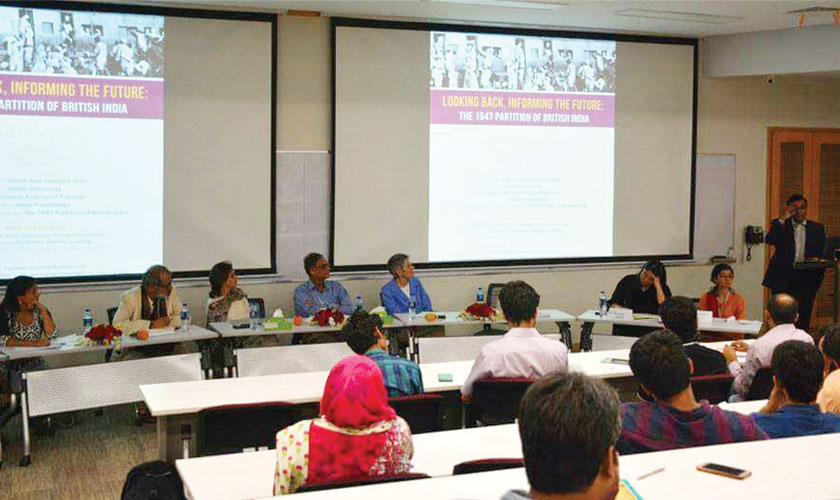For a common man, 70 years feel like an entire lifetime. But to a historian, these years are not enough to encompass the birth and death of a civilization.
UNI EVENTS
For a common man, 70 years feel like an entire lifetime. But to a historian, these years are not enough to encompass the birth and death of a civilization.
70 years have gone by since Pakistan appeared as a nation on the world map, yet it is still trying to grapple with its identity and struggling to sculpt an origin story - which isn’t forced by someone’s agenda.
To tackle these tough and prominent questions, Harvard South Asia Institute (SAI) and Faiz Foundation Trust organized talks on partition in the major cities of Pakistan. The first talk was held at Habib University. The panel included Professors Jennifer Leaning, Nadhra Khan, Nida Kirmani and Dr. Yaqoob Bangash, and Sharmeen Obaid Chinoy.

A quick survey around the hall showed the only age group missing from the audience was the infants. To see such a varied group of people united under one roof to learn about the realities of the partition was indeed heartening.
Dr. Nauman Naqvi started the discussion with a somber speech about the “deepening wounds” that the partition has left us with.
At surface level this topic may seem an easy one to speak about. Just throw in a bit of statistics about how many innocents got killed, displaced and migrated and some emotive poetry that speaks of the sacrifices made for this holy land and not a dry eye would be left in the house.
However, once you carefully unravel the layers of this historic event, you would be left with many debates and questions. As Dr. Aslam, the moderator, said, we should look at the partition not only from a “literary point of view”, but also as an event that shaped the lives of many and still continues to do so.
The prominent question that lurked around the hall was what we call this point in history. Giving names is a crucial process as one has to keep in mind the connotations of that name. Therefore, calling 14th August 1947 “Independence Day” suggests the years before this date were spent under subjugation and the years following this date we are living as a free nation. Nauman Naqvi pointed out that “partition” is just a recent addition to the list of names and it originated from the word “inqilaab”. The word “hijrat” or migration was used in the religious narrative which was pushed forward in the later years to glorify the sacrifices made by millions of Muslim migrants. This points out that we still have not settled on an encompassing word that sums up the magnitude of this event. This has also hindered us from deciding a single united identity as Pakistanis.
Moving past the abstract talk, the panelists also presented cold hard facts to the audience, some of which were deeply unsettling. Professor Jennifer Leaning’s presentation detailed the work that Harvard SAI has been doing regarding the partition of British India since 2007. Looking at this event from a humanitarian perspective, she emphasized how this has been the account of the largest migration in the world history with 15-18 million people crossing the border. She expressed her disbelief over how it has been largely ignored by historians. In her opinion, this was a “forced partition” in which freedom was attained at a huge cost, something that is largely ignored in the patriotic songs and speeches we hear today.
Another unexplored vista in this turmoil was civilian help: people opened their doors and provided shelter to complete strangers who had nothing but clothes on their backs. “How do we make this relevant in today’s time?” Professor Leaning stressed. In a world where xenophobia and suspicion is on the rise, it seems that this question is not too hard to answer.
Bringing another fresh perspective to the table Dr. Nadhra Khan, an architectural historian from LUMS, talked about how the buildings left behind by the migrants fared after the partition and how some buildings were used in the strife for independence. These buildings she explained “have lives, after lives and identities” that need to be explored. Instead, they have been “used, abused, dismembered, consecrated and their memories obliterated”. She cited an example of one such building called the Lala Lajpat Rai Bhawan where important revolutionaries gathered to discuss their independence; it is now being used as a printing press. Numerous other historic buildings are crumbling to dust and their stories are dying along with them. Not only do they need to be restored but they need to become heritage sites. An enthusiastic member from the audience pointed out the large number of Sikh and Hindu temples, churches and mosques co-existing in Pakistan but somehow their presence is overlooked along with the message of peace and tolerance they promote.
With such despairing progress it is easy to be left muddled and confused about what to do next. That is where Sharmeen Obaid Chinoy comes to the rescue. Her initiative, The Citizen Archive of Pakistan, aims to preserve these stories and narratives from our country’s past. Sharmeen pointed out that most of these stories are “literally hiding underneath people’s beds”. Regular people have relics from the past stowed away in their dusty storerooms being eaten away by mites. She urged everyone to contribute and preserve the history of our origins.
Because once we truly know our past, we can begin to shape our present and future.